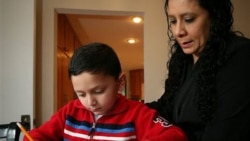Or download MP3 (Right-click or option-click and save link)
This is the VOA Special English Health Report.
Doctors currently identify autism disorders by observing behavior. Autism affects social and communication skills. It usually first appears in young children.
Now, researchers in the United States think they have found a biological test for autism. A team from Harvard University in Massachusetts and the University of Utah developed it.
The test uses an MRI or magnetic resonance imaging machine to look for abnormalities in the brain. Other studies have not shown major structural differences between the brains of autistic people and those without autism.
But the latest study did not look at the large structures of the brain. Instead, Harvard's Nicholas Lange says the team looked at the circuitry -- the chemical and electrical pathways that link the different parts of the brain.
NICOLAS LANGE: "The brain may be OK, the parts that do the work may be OK. But the wiring, the cables between the points in the brain, one to another, may be disrupted in some way."
The scientists did MRI scans on sixty males between the ages of eight and twenty-six. Thirty of them had been identified as having mild autism, a form also known as high-functioning autism.
The researchers looked at the connections in two areas of the brain that control language and social behavior. They used a technique called diffusion tensor imaging. This way they could observe microscopic fibers to see how well the brain circuitry was organized.
Nicholas Lange says the pictures showed a clear difference between the people with autism and those without. He compared it to spaghetti.
NICHOLAS LANGE: "There's a bundle of uncooked spaghetti and there's clear directionality to that. It's nice and well-organized, as opposed to a cooked bowl of spaghetti that's just a tangle of -- it looks like spaghetti. And that's the way the wiring can be. It can be either very tangled [or] it can be very organized."
The researchers say the tests were able to predict with ninety-four percent accuracy which of the people had been found to have autism. The researchers repeated their study with new participants and got equally strong results.
The results appear in the journal Autism Research.
But Doctor Lange says the test is not ready yet for general use. The study was small and only involved males. It also used older children and adults.
Doctor Lange says that, in time, the test might be able to identify autism in children under three. Three is currently the youngest age at which most doctors will diagnose an autism disorder. But most parents begin to suspect a problem by the age of two.
And that's the VOA Special English Health Report. For podcasts and transcripts, go to voaspecialenglish.com. We're also on Facebook and Twitter at VOA Learning English. I'm Faith Lapidus.
___
Contributing: Art Chimes and Caty Weaver



